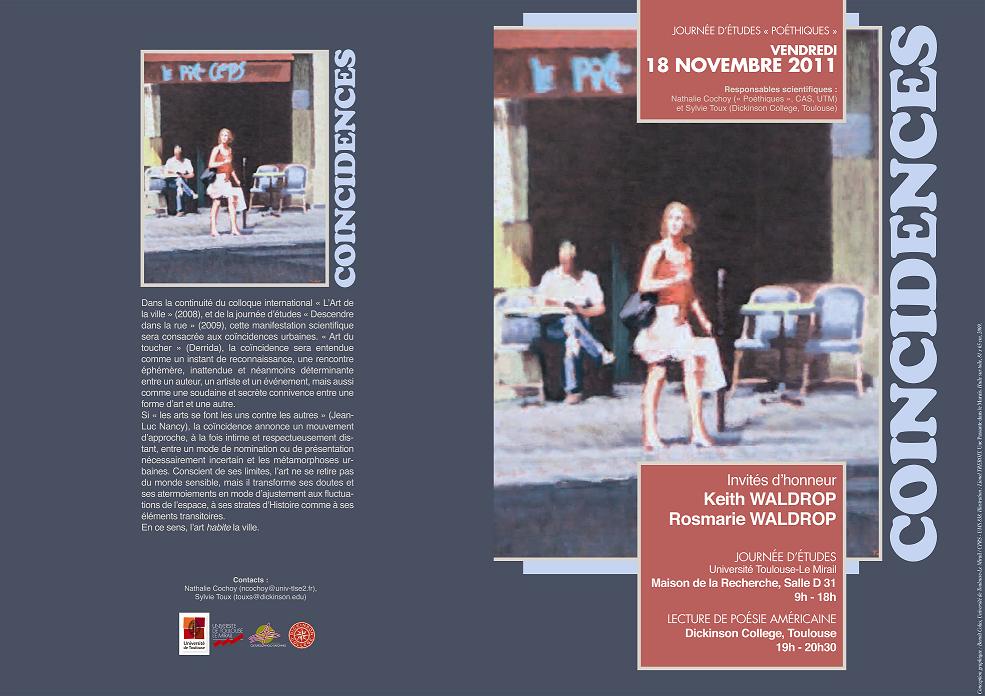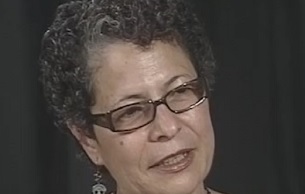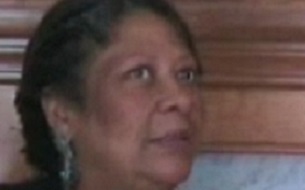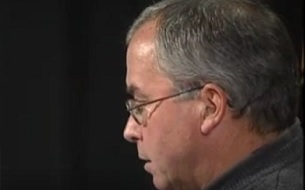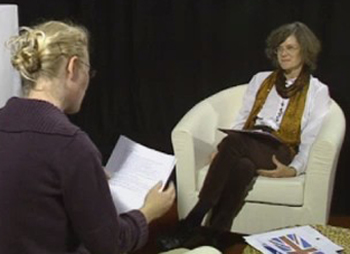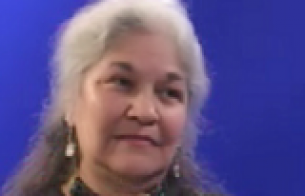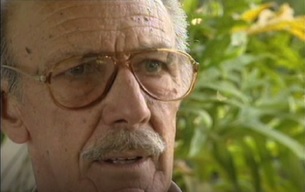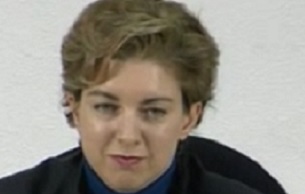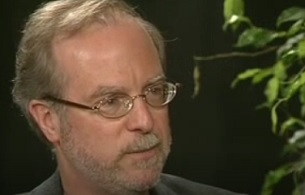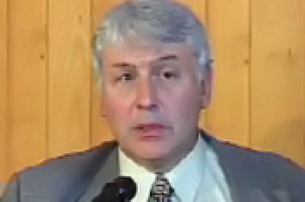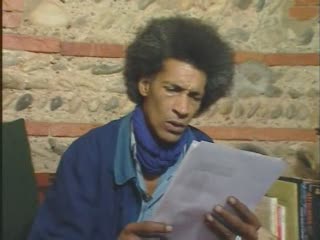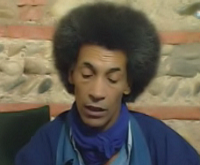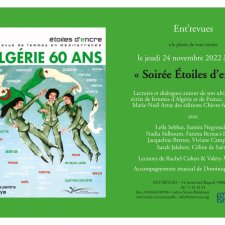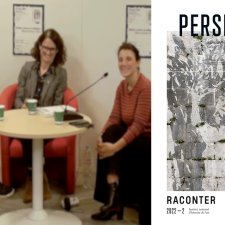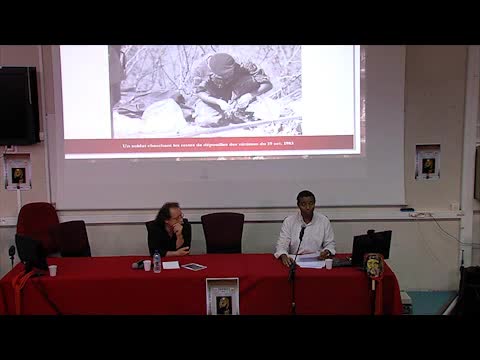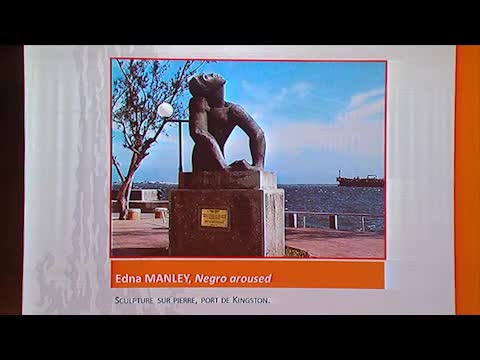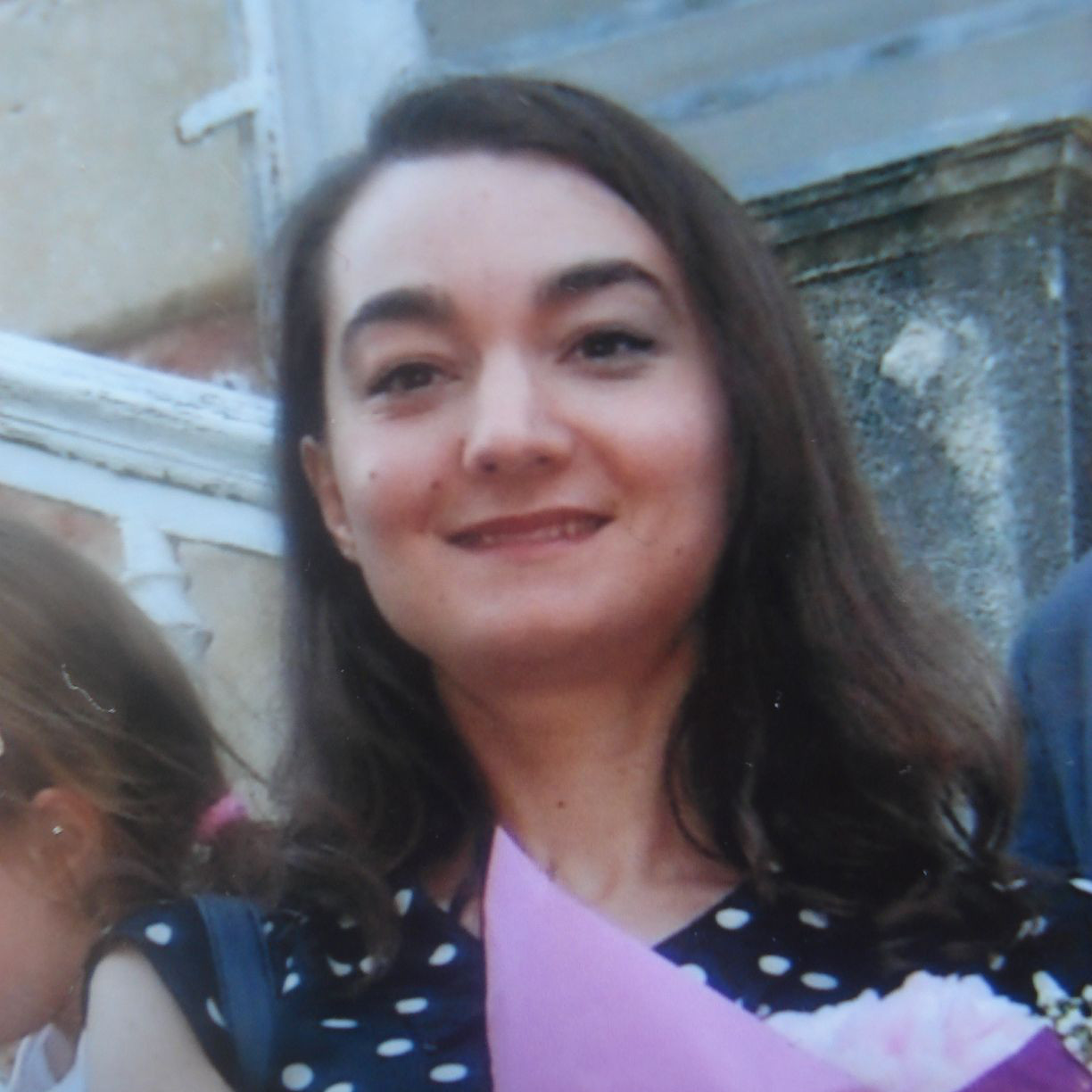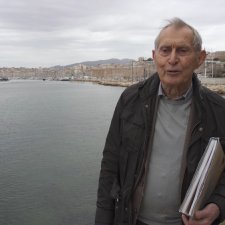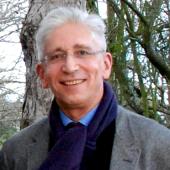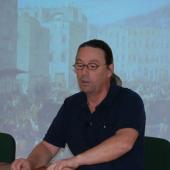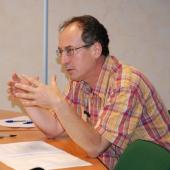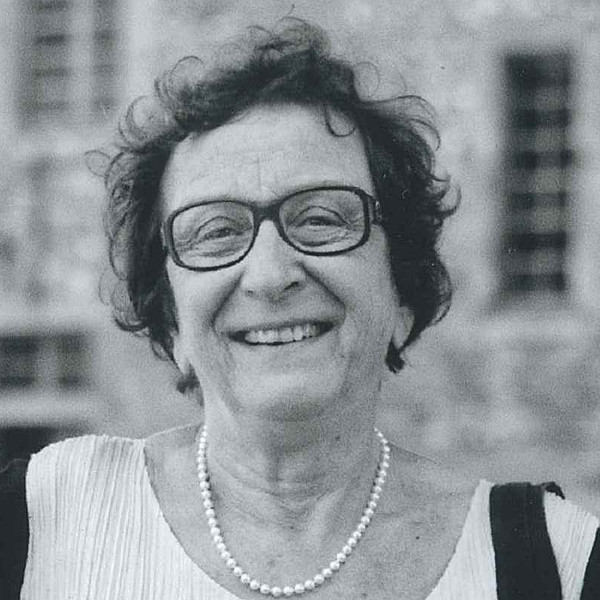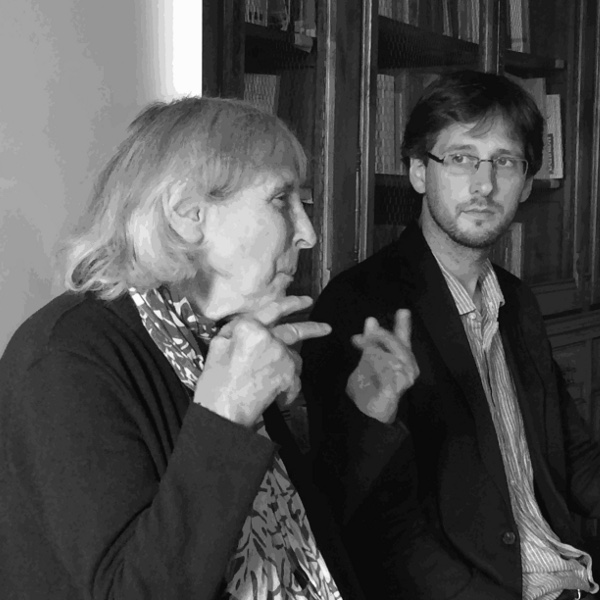Chapitres
- L'écriture de N. Scott Momaday : la naissance d'une oeuvre littéraire06'30"
- Les arts visuels : la relation entre peinture et écriture ; la photographie05'18"
- Le sens et le son des mots ; la poésie02'43"
- Du rêve à la réalité : rêve et personnages visionnaires ; la Buffalo Trust ; langues amérindiennes04'50"
- Lectures de poèmes03'14"
Notice
Entretien avec N. Scott Momaday
- document 1 document 2 document 3
- niveau 1 niveau 2 niveau 3
Descriptif
Ce programme est constitué d'une interview réalisée le 15 décembre 2000, au Centre audio-visuel de l'Université de Toulouse-Le Mirail par Christiane Fioupou et Françoise Besson. N. Scott Momaday, Indien Kiowa qui enseigne la littérature anglaise et américaine à l'Université d'Arizona est l'auteur de deux romans, "House Made of Dawn" (La Maison de l'aube), qui obtint le Prix Pulitzer en 1969, de deux autobiographies, "The Way to Rainy Mountain" (Le Chemin de la montagne de pluie) et "The Names" (Les Noms), disponibles en version française, et de plusieurs recueils de poèmes. Il est aussi l'auteur de "Circle of Wonder : A Native American Christmas Story", conte qu'il a lui-même illustré. Il a également écrit la préface de l'ouvrage sur Curtis, "Sacred Legacy : Edward S. Curtis and the North American Indian" (Edward Sheriff Curtis et l'Indien d'Amérique du Nord), ouvrage dans lequel Christopher Cardozo et Joseph Horse Capture introduisent les photographies de Curtis. N. Scott Momaday est également peintre.
Dans cette interview, il évoque la genèse d'un roman, le rôle de l'histoire dans sa vision des choses, son rapport à la poésie et à la peinture, l'influence des paysages sur son écriture. Cet entretien, traduit en français, est accompagné d'une biographie et d'une bibliographie de l'écrivain ainsi que d'un lexique.
Intervention / Responsable scientifique
Thème
Documentation
Documents pédagogiques
Un écrivain amérindien parle de son art et de sa vision du monde.
- How would you introduce yourself ?
- Visual arts : the relationship between painting and writing ; photography
- The sound and the sense of words ; poetry
- From dream to reality : dream and visionaries ; the « Buffalo Trust » ; Native American language
How would you introduce yourself?N. Scott Momaday: I would say I am Scott Momaday, that is true; but I am also Tsoai Talee, which is my Indian name and it means “Rock Tree Boy” and I was given that name when I was an infant because I have been taken to a sacred place in Kiowa tradition, which is called Rock Tree, Tsoai.How and why do you react when critics call you an “Indian writer”?It is true, I think, Ah yes, I am an writer; but I do also think that it is demeaning in a way to categorize writers in ethnic terms. I would rather be known as a writer than as a Jewish writer or an Indian writer or a Black writer. When and why did you start writing fiction? How rewarding the experience? I think I went to Stanford with a fellowship in poetry, writing poetry and I wrote poetry for several years, and I think I got tired of poetry, rather stale, and I worked myself into a corner and so I turned to fiction, because it gave me more flexibility, and I found out that I could write fiction as well as poetry and so I do both things now.Were you influenced by great literary figures?I suppose so; it would be hard to identify particular writers but certainly I’ve read writers I admire a great deal and I am sure they must have had some influence upon me.
I’m very fond of Emily Dickinson, the American poet, Herman Melville —Moby Dick — ; Izak Dinesen is a someone I admire very much, a Danish writer who wrote Out of Africa; I think her prose is just really as good as it gets in twentieth century English literature.
When you write a novel, how do you start?I think of what it is the novel is going to become as far as I can; I think about it for a long time. And when it seems propitious I start, I write the first word followed by the second word and the third. The beginning is a time of great mental activity but not necessarily writing; and when the writing comes it comes a word at a time. And so that’s basically the process.How would you assess the part played by history in your works?I think I can answer that best by quoting a Professor of mine some years ago who said that unless we understand the history that produced us we are determined by that history; we may be determined in any event but the understanding gives us a chance. So I think that history is important. I have ideas about that but I probably don’t have time to go into. I think because of my American Indian background, I have a different idea of time than have other people and so I think of history in a different way than perhaps other people do. But it’s important to me.Would you say that there are recurrent— and possibly obsessive — themes in the fiction or poems you write? There certainly are recurrent themes; obsessive, I don’t know... Perhaps.Could you identify some of them?I am interested in Time and I incorporate the element of Time into my work in various ways. I don’t proceed chronologically and House Made of Dawn is a good example of where I jump back and forward in Time. That’s something that I am interested in very much. I’m very much interested in how we exist in the element of Time, how we think of it, because I think the way we think of it determines how we act; and so ... two years ago I had a wonderful experience of going through the Grand Canyon on a raft and it was a wonderful experience to pass through geologic time and to reflect upon timelessness, which in effect is like moving into eternity.The landscape and particularly the landscape around Jemez Pueblo is particularly important in your works? What is the impact of location on characterization and thematic structure in your fiction?It’s very important. The sense of place is paramount. And you’re right: I spent my most impressionable years in that landscape around Jemez Pueblo and I still live in that country. It is incomparably beautiful and full of timelessness. There are ancient evidences of human habitations there and it’s very conducive to my state of mind, my equilibrium, my sense of belonging.
Visual arts : the relationship between painting and writing ; photographyAs a writer and as a painter what relationship do you see between your writing and your painting or more generally between literature and visual arts?The relationship between painting and writing is close, I think. Both things express my spirit equally, and I enjoy doing both things. I find that painting is much more relaxing, it requires far less concentration, so it is a way of turning from writing, which is a very concentrated experience, to something more relaxing; and so I think I restore myself when I paint and I spend myself when I write.Is there a painter or a school of painting you love more than others?A school, probably not. Certain painters are very important to me. I like Emil Nolde. I like his work very much. There is a painting which is called Sternenwandler, which I think is one of the most haunting paintings that I know. I like some Native American painters I admire very much: Fritz Sholder I like very much; his father was a painter and I think that what he did was quite wonderful. His last paintings were his best, which is a wonderful thing to say about a painter or a writer for that matter; he’s kept getting better.When you paint do you consider colors as an instrument, a way of reproducing reality or a visionary language? NSM: Visionary language, of those choices. Color it seems to me... I don’t think a lot about color. I allow it happen. I think I began not as a colorist. I like black and white. I like drawing in ink on white paper and I still think of that as something that is very important to do. Most people have a false view of drawing and think of it as a preliminary painting but I think of it as an end in itself. And color when it comes has just a different dimension but as I said, it happens I don’t think about colors so much.What is the role of photographs in your work, particularly in your autobiography, The Names?I think photographs are extremely important to me. I enjoy taking photographs and looking at them; and I think of them as works of art in the same way that paintings are. And in The Names, I was fortunate to find a number of photographs from my family, photographs of myself as a child, photographs of my parents as young people and as children, and so those were very important to me. I think they are a very valid dimension of that particular book.Some people think that Curtis’s photographs are artificial and give a vision of Native Americans which is idealized but not true. How do you perceive those photographs?All photographs are artificial in some sense. They’re like movies. You know, they’re like projections of images on a plane. If you get close enough they dissolve into grain. So they’re not reality. But they are wonderful as visual, as symbolic events, as symbolic representations. And Curtis ... I have a great deal of respect for Curtis, because I think he came along at the right time, he was dedicated to representing the American Indian and, goodness knows he did far more than anyone else to my knowledge in giving us visual representations of the Indians at the turn of the century, and that’s very valuable to us, you know, that’s an archive that we need. And so .... I just saw the exhibit of Curtis in Paris. It’s quite wonderful. I think more of him as time goes on. My appreciation for Curtis grows.What do you draw your literary “inspiration” and the materials in your painting from?My experience, growing up in the South West, the landscape there, the people there; my parents were very creative people, both of them. My mother was a writer, my father a painter, and I grew up in a very creative household, and I derive a lot of inspiration from that.An Interview with N. Scott Momaday
The sound and the sense of words ; poetryWhen you use Indian words in your fiction why don’t you most of the time give a translation? For example, you give a glossary in your autobiography, but not in your novels. Why is that?I don’t feel the need to do that. Words sometimes are effective even if you do not know the meaning. It’s the sound of the word; the idea that the word comes from a particular experience, racial experience or cultural experience. Georgia O’Keeffe was once asked why she didn’t sign her paintings and she said: “Why don’t you sign your face?” It’s not necessary always to explain things. Izac Dinesen once said: “It’s not a bad thing that only half the story is understood ”; and I quite agree with that.Would you prefer the novel or the autobiography as a genre?I don’t want to choose between them... They’re both less important than poetry.So poetry is your favorite genre...It is... yes, it is my favorite and it is the most important. I agree with the writer Lewis Thomas who said, well, language really falls into four categories: there is small talk, cocktail party, chitchat, then there is conversation, in which meaning is transferred, information is communicated, and there is mathematics, and finally there is poetry. So I would agree with that. Are you constantly writing poetry?I write it more often than anything else. I don’t write all the time; but I do write poetry more consistently, I guess, than other kinds of writing.Do you sometimes write poetry and painting, you know, one corresponding to the other?Yes, yes, I write them, you know, at the same time. I go back, I go from one to another and back again; and sometimes the themes are related. So that I’m expressing an idea in language and then expressing something of the same idea in painting.
Some of my books are illustrated; I have not published a book solely of paintings and drawings. But I have published a number of writings that I have illustrated.
From dream to reality : dream and visionaries ; the « Buffalo Trust » ; Native American languagesWhat is the role of dreams in your vision of things?Dreams are extremely important to me and to, I think, Indian people in general, and to children; children dream. So I have a great belief in the efficacy of dreams. I like it when I dream and I like to dream, even daydream; you know, I like to sit and encourage my mind to go in that dimension of dreams. Something good comes of it, I think.In your novels there quite a lot of characters could be called visionaries ? Do you agree? Visionaries, yes. I think those people are extremely important to us. I like people who are visionaries. I once heard or read a conversation between two people; one of them said: “we must take care lest we produce a generation of impractical visionaries.” And the other replied: “Dear God, for just one impractical visionary in a score of generations.” I think visionaries are very important and we need them.How do you see the relationship between Nature, men and men and animals?They’re all of a piece. We exist in the element of Nature in spite of the fact we sometimes want to destroy Nature. Men and animals are closely related as they both cross a large spectrum of experience. I like cave bears and cave bears like me. We come from the same source and if you go back far enough.Is there a question you would like me to ask?Yes, I would like you to ask me about my work, my Foundation which is called the “Buffalo Trust”. I have a foundation and it’s extremely important to me. It is something I am giving the rest of my life to. It is an organization to help Indian children and other indigenous children to recover their heritage. And I think the greatest threat to American Indian culture at the moment is the loss of cultural identity. Children are losing their languages, they are losing their ceremonial life, they’re losing their contact with elders. So I want to reverse that if I can, do something about it. So my Foundation is designed to do that.Can you tell me something about your language?I have several languages. But you mean my Kiowa language. I’d like and tell you that I don’t speak it, I can understand some of it. I never had the chance to learn it because my parents moved away from Kiowa people when I was very small. So I actually heard more Navaho than Kiowa and I heard more Jemez Pueblo than Kiowa. But the Kiowa language is an interesting language, because it doesn’t appear to be like other languages around it. It has been very hard for the linguists to classify it. It’s thought now to be Tanoan; but I know at one time it was considered Caddoan and then Uto-Azteccan. So, I’m not a linguist, but the language seems to me unique, very particular, and distinguished in itself.Did your parents communicate in their Kiowa language?No, my mother is not ....was not Kiowa. My father was fluent in Kiowa. But my mother was French, English and Cherokee. And so English was the language of my household.Do you speak a bit of Cherokee?No, no Cherokee; a little Kiowa, some Navaho, some Jemez.Can you say something in Kiowa just for us to listen?Gyet Angya Gyet Angya Hon Dei Hon Dei Gyet Angya Beso Beso. Hello, sit down, be comfortable. That’s what it sounds like.A very incantatory language.Yes, I would say so.
Dans la même collection
-
Lecture de poésie américaine : Rosmarie et Keith Waldrop
WaldropRosmarieWaldropKeithPoyetPascalBroquaVincentBrossardOlivierLecture de poésie américaine : Rosmarie et Keith Waldrop. "Coïncidences", in journée d'études de Poéthiques organisée par le laboratoire Culture Anglo-Saxone (CAS) de l'Université Toulouse II-Le
-
Entretien avec Helena Maria Viramontes
HardingWendyViramontesHelena MaríaHelena Maria Viramontes, écrivaine « chicana » et professeur de l’Université de Cornell (USA) a reçu de nombreuses récompenses pour ses romans et nouvelles (The Moths and Other Stories, Under the
-
Entretien avec Marilyn Nelson, poète lauréate du Connecticut
HardingWendyNelsonMarilyn« Je m’appelle Marilyn Nelson. Je suis née à Cleveland, dans l’Ohio en 1946. Ma mère était dans l’enseignement et mon père était officier de carrière dans l’aviation américaine, si bien que j’ai
-
L'histoire afro-américaine à travers la poésie de Marilyn Nelson
HardingWendyL’œuvre de Marilyn Nelson, poète afro-américaine, porte une réflexion sur le rôle des noirs dans l’histoire américaine. Dans cette lecture de poèmes choisis de ses recueils, Marilyn Nelson fait
-
Les minorités ethniques en Grande-Bretagne / John Moore
MooreJohnCacquerayElizabeth deCet entretien informel aborde le thème des minorités ethniques en Grande-Bretagne à l’époque contemporaine. Il fait remarquer que les résultats de recherches récentes sur les minorités ethniques
-
Petite introduction à l'histoire de la Grande-Bretagne / Elizabeth De Cacqueray
CacquerayElizabeth deCet entretien informel entre une jeune étudiante britannique qui poursuit ses études en France et une enseignante de l’Université de Toulouse-Le Mirail introduit quelques aspects de l’histoire et de
-
Entretien avec Anne Dunn, conteuse Anishinabe-Ojibwe
HardingWendyDunnAnne M.Anne Dunn, conteuse charismatique de la nation Ojibwe (Amérique du Nord) parle de son peuple, ses terres, son histoire, la lutte pour ses droits. Elle réfléchit aussi sur sa quête spirituelle, les
-
Histoire d'une plantation de café au Kilimandjaro / Bernard Charlery de la Masselière, Emmanuel Nick
Charlery de La MasselièreBernardEmmanuelNickNick Emmanuel, colon grec, propriétaire d'une plantation de café en Tanzanie raconte l'histoire de cette plantation depuis 1906. Il évoque la question de la colonisation et de la nationalisation
-
Autre pays, autres moeurs
StentonAntonyBricker-TailleferGailFarrisLaurieLe consul des États-Unis à Toulouse, Laurie Farris, discute les différences culturelles constatées par les hommes d'affaires américains en France. Tourné au moment d'une grande incompréhension
- Ethique des affaires
- Conjoncture et conditions économiques
- Culture, institutions sociales (institutions ou associations culturelles, action culturelle, comportements culturels, anthropologie culturelle, sociologie culturelle, économique, politique, religieuse)
- Corruption des entreprises
- Culture entrepreneuriale
-
Entretien avec Jeffrey Cole
StentonAntonyColeJeffreyUne interview de Jeffrey Cole qui a été directeur du Centre de Politique de la Communication et des Médias de Divertissement à UCLA faculty, UCLA’s Center for Communication Policy (University of
-
Entretien avec Eric Arnesen
HardingWendyArnesenEricUn entretien avec Eric Arnesen, professeur d'histoire des relations du travail dans la communauté afro-américaine. Générique Interview : Wendy Harding Réalisation et post-production : Bruno
-
Entretien avec Michael Salvaris
StentonAntonySalvarisMichaelMichael Salvaris, enseignant-chercheur à l'Institut de recherche en Sciences Sociales à l'Université de Technologie de Swinburne, à Melbourne en Australie, évoque dans cette interview, la position de
Avec les mêmes intervenants et intervenantes
-
Poésie Touareg, Hawad
HawadClaudot-HawadHélèneFioupouChristianeHéritier d'une culture nomade, Hawad, poète et peintre touareg, nous fait découvrir son oeuvre à travers deux poèmes qu'il nous lit et qu'il commente. Les poésies sont accompagnées de ses manuscrits
-
Hawad : recycler les horizons, poésie et furigraphie
HawadClaudot-HawadHélèneFioupouChristianeHawad, poète né dans l'Aïr, pays touareg qui se situe au centre du Grand Désert (Sahara), « poète du détournement des métaphores et des situations »... il nous parle de son travail graphique, de sa
Sur le même thème
-
Rome en couleurs
BarbetAlixQuasiment tous les types de bâtiments à Rome étaient colorés. Peintures et mosaïques, parfois luxueuses, ornaient maisons, palais mais aussi tombes. Leur redécouverte nous permettra d'évoquer une Rome
-
ENT'REVUES : "SOIRÉE ÉTOILES D'ENCRE"
ArrasMarie-NoëlNegroucheSamiraJalabertSarahBrenotJacquelineSebbarLeïlaDobrinovaEkaterinaDe SaërCélineMeynadierValéryBertrandDominiqueEnt’revues vous invite à une soirée spéciale organisée avec les Éditions Chèvre-feuille étoilée et la revue Étoiles d’encre autour de leur ultime numéro qui rassemble des écrits de femmes d’Algérie et
-
Soirée de présentation de l'ouvrage "Perspective - Raconter - n° 2022 - 2"
PoilpréAnne-OrangeCaillatMarieHugounenqSarahLà où apparaît une image, qu’elle soit fixe ou animée, figurative, aniconique, matérielle ou mentale, surgissent une histoire et une manière d’en agencer le récit. L’image et l’objet d’art racontent
-
Peindre la révolution à la Grenade : trauma(s), censure(s), libération(s)
LefrançoisFrédéricBerthetDominiquePeindre la révolution à la Grenade : trauma(s), censure(s), libération(s) Colloque
-
Regards croisés sur l'Atelier 45 et le Jamaican Art Movement
LefrançoisFrédéricCommunication au colloque "Rendre hommage à l'Atelier 45" Octobre 2016 Tropiques ATRIUM - Scène nationale Fort-de-France, Martinique
-
Le chef-d'oeuvre inconnu de Jacques Rivette
La communication (notamment redevable aux analyses de F. Dosi, auteure d'une thèse sur les "trajectoires balzaciennes dans le cinéma de J. Rivette") enquête sur le sens et les modalités de l
-
Roland Courtot, Turner et la façade maritime de Marseille | Rencontres méditerranéennes de TELEMMe …
CourtotRolandRoland Courtot, professeur émérite de géographie à TELEMMe (AMU-CNRS), montre comment l'analyse des œuvres du peintre William Turner permet d'appuyer un travail de géographie de l'art, dans une vidéo
-
Pour en finir avec l’impressionnisme littéraire. Un essai de métastylistique
À travers le cas de l'impressionnisme littéraire, cet article se propose d'interroger une forme de « réalisme » qui s'est construite sur « un rapport au référent orienté par la notion de fidélité »
-
La révolution napolitaine mise en images
Au cours de la révolution napolitaine de 1647-1648, l'iconographie joue un rôle politique et culturel important non seulement dans le cours même des événements, mais aussi par la diffusion de l
-
L'or des peintres : une histoire de l'argent du XVème au XVIIème siècle
Cette intervention vise à présenter la démarche de recherche, le corpus (centré sur la peinture), les modes d'analyse (à partir de dossiers précis comme la mise en image des hommes d'argent ou l'effet
-
L’espace tragique du vide dans la poésie de Paul Celan et les toiles d’Anselm Kiefer
Les poésies de Paul Celan tout comme les toiles d’Anselm Kiefer sont traversées par le traumatisme de la Shoah. Pour Celan, poète roumain d’origine juive, écrivant en allemand, il est impossible de
-
Un trait de crayon maintenu hors du pinceau
Du burin à la mine de plomb, au pigment, différentes latitudes de l'œuvre de Tal Coat. La gravure saisit, le dessin au trait et au fusain irradie, le pigment met une terre à brûler à la lumière...



